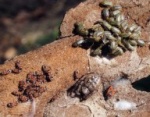Identificar hongos de Madagascar
2 participantes
EL ÁRBOL DE LA VIDA :: BIODIVERSIDAD ONLINE :: GALERÍA DE IDENTIFICACIÓN :: IDENTIFICACIÓN DE OTROS GRUPOS
Página 1 de 1.
 Identificar hongos de Madagascar
Identificar hongos de Madagascar
Solicito ayuda para identificar algunas fotos que no son mías, de diversas especies fotografiadas en Madagascar, para poder continuar con una expo sobre la vida en el mayor y uno de los más amenazados Puntos Calientes de Biodiversidad del planeta tierra, con un altísimo grado de endemismos y de maravillas evolutivas producidas por un aislamiento milenario.
1. http://www.flickr.com/photos/jungle_boy/4982014142/
2. http://www.flickr.com/photos/33037982@N04/3444961367/
3. http://www.flickr.com/photos/sparkyt...at/4213030170/
4. http://www.flickr.com/photos/kruttekrax/3200220412/ este será un Anthurus o parecido, no?
5. http://www.flickr.com/photos/pix-diana/4229899278/
6. http://www.flickr.com/photos/rowe_becky/4654488594/
7. http://www.flickr.com/photos/33037982@N04/3444961357/
8. http://www.flickr.com/photos/33037982@N04/3445797418/
9. http://www.flickr.com/photos/grandma-shirley/3182681273/
10. http://www.flickr.com/photos/grandma-shirley/3183515062/
11. http://www.flickr.com/photos/grandma-shirley/3183529688/
12. http://www.flickr.com/photos/42244964@N03/4022299793/
13. http://www.flickr.com/photos/42244964@N03/4022300785/
14. http://www.flickr.com/photos/16343559@N04/2101024237/
15. http://www.flickr.com/photos/grandma-shirley/3183517226/
16. http://www.flickr.com/photos/25242263@N07/2381103458/
17. http://www.flickr.com/photos/glowingz/2511390988/
18. http://www.flickr.com/photos/jdigittl/2752849294/
19. http://www.flickr.com/photos/wggyfrog/2447775499/
20. http://www.flickr.com/photos/rowe_becky/4664109807/
Muchas gracias,
Isidro
1. http://www.flickr.com/photos/jungle_boy/4982014142/
2. http://www.flickr.com/photos/33037982@N04/3444961367/
3. http://www.flickr.com/photos/sparkyt...at/4213030170/
4. http://www.flickr.com/photos/kruttekrax/3200220412/ este será un Anthurus o parecido, no?
5. http://www.flickr.com/photos/pix-diana/4229899278/
6. http://www.flickr.com/photos/rowe_becky/4654488594/
7. http://www.flickr.com/photos/33037982@N04/3444961357/
8. http://www.flickr.com/photos/33037982@N04/3445797418/
9. http://www.flickr.com/photos/grandma-shirley/3182681273/
10. http://www.flickr.com/photos/grandma-shirley/3183515062/
11. http://www.flickr.com/photos/grandma-shirley/3183529688/
12. http://www.flickr.com/photos/42244964@N03/4022299793/
13. http://www.flickr.com/photos/42244964@N03/4022300785/
14. http://www.flickr.com/photos/16343559@N04/2101024237/
15. http://www.flickr.com/photos/grandma-shirley/3183517226/
16. http://www.flickr.com/photos/25242263@N07/2381103458/
17. http://www.flickr.com/photos/glowingz/2511390988/
18. http://www.flickr.com/photos/jdigittl/2752849294/
19. http://www.flickr.com/photos/wggyfrog/2447775499/
20. http://www.flickr.com/photos/rowe_becky/4664109807/
Muchas gracias,
Isidro

Isidro- Admin

- Cantidad de envíos : 17122
Fecha de inscripción : 08/01/2011
 Re: Identificar hongos de Madagascar
Re: Identificar hongos de Madagascar
Gracias Carlos, ¿es seguro? Pensaba que este tipo de faláceas con redecilla debajo eran del género Dictyophora...

Isidro- Admin

- Cantidad de envíos : 17122
Fecha de inscripción : 08/01/2011
 Re: Identificar hongos de Madagascar
Re: Identificar hongos de Madagascar
Son sinónimos. Te pego un texto por si te sirve para acercarte a la especie:
Phallus multicolor is similar to Phallus indusiatus in overall appearance, but it has a more brightly colored cap, stem and indusiatum, and it is usually smaller. It is found in Australia, Guam, Sumatra, Java, Borneo, Papua New Guinea, Zaire, and Tobago.[20] The cap of the Indo-Pacific species Phallus merulinus appears smooth when covered with gleba, and is pale and wrinkled once the gleba has worn off. In contrast, the cap surface of P. indusiatus tends to have conspicuous reticulations that are not obscured even when covered with gleba. Also, the indusium of P. merulinus is more delicate and shorter than that of P. indusiatus, and thus less likely to collapse under its own weight.[21] P. cinnabarinus, a Taiwanese species found under the bamboo Dendrocalamus latiflorus, grows to 13 cm (5.1 in) tall, and has a more offensive odor than P. indusiatus. It attracts flies from the genus Lucida, rather than the house flies of the genus Musca that prefer P. indusiatus.[22] P. echinovolvatus, described from China in 1988, is closely related to P. indusiatus, but can be distinguished by its volva which has an echinulate (spiky) surface, and its higher preferred growth temperature of 30 to 35 °C (86 to 95 °F).
Phallus multicolor is similar to Phallus indusiatus in overall appearance, but it has a more brightly colored cap, stem and indusiatum, and it is usually smaller. It is found in Australia, Guam, Sumatra, Java, Borneo, Papua New Guinea, Zaire, and Tobago.[20] The cap of the Indo-Pacific species Phallus merulinus appears smooth when covered with gleba, and is pale and wrinkled once the gleba has worn off. In contrast, the cap surface of P. indusiatus tends to have conspicuous reticulations that are not obscured even when covered with gleba. Also, the indusium of P. merulinus is more delicate and shorter than that of P. indusiatus, and thus less likely to collapse under its own weight.[21] P. cinnabarinus, a Taiwanese species found under the bamboo Dendrocalamus latiflorus, grows to 13 cm (5.1 in) tall, and has a more offensive odor than P. indusiatus. It attracts flies from the genus Lucida, rather than the house flies of the genus Musca that prefer P. indusiatus.[22] P. echinovolvatus, described from China in 1988, is closely related to P. indusiatus, but can be distinguished by its volva which has an echinulate (spiky) surface, and its higher preferred growth temperature of 30 to 35 °C (86 to 95 °F).
 Re: Identificar hongos de Madagascar
Re: Identificar hongos de Madagascar
Gracias Carlos. Vaya, parece que esas especies no se mencionan de Madagascar. De todos modos se ve que este tipo de hongos (Phallus, Clathrus y parientes) son bastante cosmopolitas...

Isidro- Admin

- Cantidad de envíos : 17122
Fecha de inscripción : 08/01/2011
 Re: Identificar hongos de Madagascar
Re: Identificar hongos de Madagascar
La 12 se parece mucho a Microporus xanthopus, uno de los pocs hongos tropicales que tengo en la colección, tal vez sea de ese género, o al menos de la Polyporaceae.
En cuanto al 16 parece un Pycnoporus sanguineus.
En cuanto al 16 parece un Pycnoporus sanguineus.
 Re: Identificar hongos de Madagascar
Re: Identificar hongos de Madagascar
Gracias Carlos. Antes de incluirlos y dado que no estás del todo seguro, ¿esas dos especies son nativas de Madagascar?

Isidro- Admin

- Cantidad de envíos : 17122
Fecha de inscripción : 08/01/2011
 Re: Identificar hongos de Madagascar
Re: Identificar hongos de Madagascar
Son especies tropicales que encontré en Australia, y de distribución muy amplia, llegando a Africa, pero no se si también a Madagascar.
EL ÁRBOL DE LA VIDA :: BIODIVERSIDAD ONLINE :: GALERÍA DE IDENTIFICACIÓN :: IDENTIFICACIÓN DE OTROS GRUPOS
Página 1 de 1.
Permisos de este foro:
No puedes responder a temas en este foro.
 Índice
Índice
